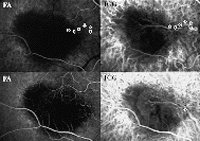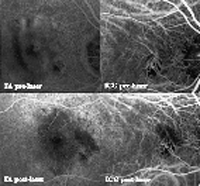Dynamic ICG angiography allows better aimed laser treatment of AMD
Detection of smaller feeder vessels increases the rate of success of the treatment, authors say.
MILAN, Italy — Indocyanine green angiography (ICGA)-guided laser treatment of feeder vessels may be useful in the management of the subfoveal choroidal neovascular membranes (CNVM) occurring in patients with age-related macular degeneration (AMD). This is the conclusion of a pilot study, carried out in Milan, at the University Eye Clinic, by Giovanni Staurenghi, MD, in collaboration with Nicola Orzalesi, MD, and other colleagues.
“The treatment of subfoveal CNVM in age-related macular degeneration still remains a key problem for most ophthalmologists and patients,” Dr. Staurenghi said. Previous studies have shown the beneficial effects of direct laser treatment on CNVM. However, direct treatment of the foveal area is invariably associated with a sudden and considerable decrease in visual acuity. Although the patients are informed that the decrease will lessen over subsequent years, it is still difficult for elderly people, with a relatively short life expectancy, to accept such a “punitive” procedure. For this reason, “any method that stabilizes or slows the growth of CNVM could be useful in these patients,” he said.
“ICGA allows a better location and more selective laser treatment of feeder vessels, with the aim of obtaining a smaller scar, thereby sparing the fovea,” he said. In addition, this technique allows the detection of smaller feeder vessels that are not revealed by fluorescein angiography, and which seem to be essential to the success of the treatment.
The treatment
 --- The identification of feeder vessels was based on their injection, preceding that of the retinal vessels, during the early phases of dynamic fluorescein angiography and ICG angiography, and on their relationship with choroidal circulation and the CNVM during the course of angiography.
--- The identification of feeder vessels was based on their injection, preceding that of the retinal vessels, during the early phases of dynamic fluorescein angiography and ICG angiography, and on their relationship with choroidal circulation and the CNVM during the course of angiography.
A total of 45 AMD patients with newly diagnosed CNVM participated in the study. Patients with a history of allergy to sodium fluorescein or indocyanine green were excluded.
Fluorescein angiography and ICG angiography were performed using scanning laser ophthalmoscopes (SLO 101, Rodenstock Instrument GmbH, Ottobrunn-Riemerling, Germany, and Heidelberg Retinal Angiograph HRA, Heidelberg Engineering, Heidelberg, Germany). The identification of feeder vessels was based on their injection, preceding that of the retinal vessels, during the early phases of dynamic fluorescein angiography and ICGA, and on their relationship with choroidal circulation and the CNVM during the course of angiography.
Relocating the feeder vessels
 ---Fluorescein angiography and ICG angiography are shown pre- and post-laser.
---Fluorescein angiography and ICG angiography are shown pre- and post-laser.
Once located by means of dynamic ICGA, the feeder vessels were easy to relocate in the fundus during the photocoagulation session. In case of doubt, the relationship between the laser spot and the feeder vessels were checked by means of angiography after the injection of a small amount of dye (0.5 cc). An argon laser (514 nm Ophthalas SP, Alcon) was used to treat the feeder vessels. The treatment was administered in two consecutive steps: the first using a 100 µm laser beam for 0.2 to 0.4 seconds and 150 to 250 mW power coagulation, sufficient to produce burns of moderate intensity on both sides of the feeder vessel; the second using a 100 or 200 µm beam and 150 to 300 mW power coagulation over the feeder vessel. ICG angiography was repeated immediately after the laser treatment using 1 mL of 10% indocyanine green solution, followed by 5 mL saline.
The baseline examination (including fluorescein angiography and ICG angiography) was repeated 48 hours, 7 days, 1 month and every 3 months after photocoagulation. Whenever ICGA showed residual feeder vessel filling, laser re-treatment immediately was performed.
High rate of success
Success was defined as the stable obliteration of the feeder vessels and CNVMs. In many instances, more than one treatment was needed to obtain the occlusion.
“Laser treatment of the feeder vessels was successful in about 50% of the cases, with a medium increase in visual acuity that is remarkably higher than that generally found in the literature or clinical practice,” Dr. Staurenghi said. “One reason for this may have been the narrowness of the treatable feeder vessels revealed by dynamic ICGA. Since only the larger feeder vessels are revealed by fluorescein angiography, it can be suggested that one of the reasons for the failures in past experiences may be that only larger feeder vessels were treated.”
The important advantages of feeder vessel-limited treatment of the subfoveal membrane are as follows:
- It preserves the possibility of other forms of treatment.
- It does not interfere with a favorable natural history in the case of a stable membrane.
- It does not create larger areas of ischemia that may stimulate further neovascularization.
“We are greatly encouraged by our results,” Dr. Staurenghi said. However, he said that a comparable success rate would have been unlikely using the other currently available methods of treating subfoveal CNVMs.
“Therefore, we consider that this re-evaluation of an abandoned procedure, with the use of new technology, urgently deserves to be verified by means of adequate randomized controlled trials. These should not only confirm the value of the procedure, but also clarify the importance of the factors involved in the success rate,” Dr. Staurenghi said.
For Your Information:
- Giovanni Staurenghi, MD, practices at the S. Paolo Hospital, Institute of Biomedical Science, University Eye Clinic, Milan. He can be reached at Ospedale San Paolo, Clinica Oculistica, Via Di Rudinì 8, 20142, Milan, Italy; +(39) 02-8184572; fax: +(39) 02-8139221; e-mail: gio1@imiucca.csi.unimi.it. Dr. Staurenghi has no direct financial interest in any of the products mentioned in this article, nor is he a paid consultant for any companies mentioned.
